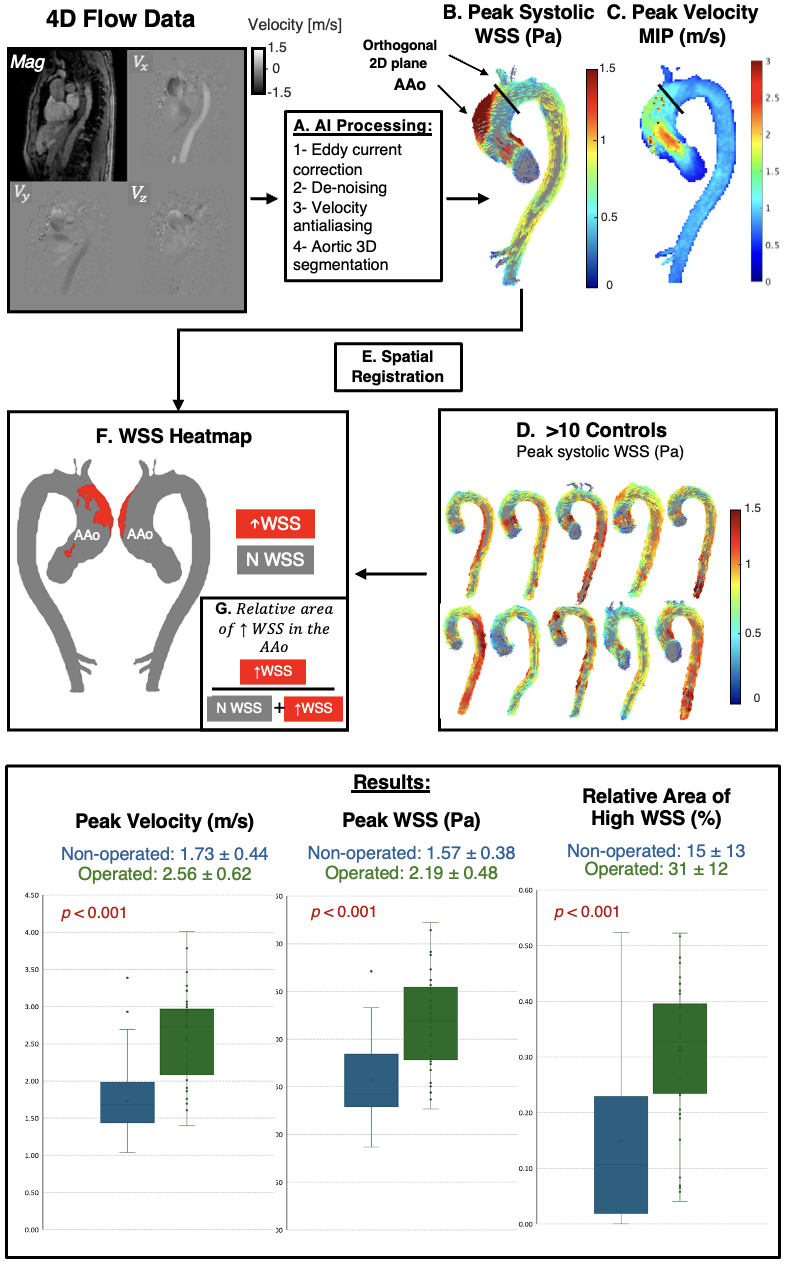Final ID: MDP191
Long-Term Predictive Value of 4D Flow MRI in Bicuspid Aortic Valve Patients: A 10-Year Assessment for Aortic Surgery Risk
Abstract Body (Do not enter title and authors here): Introduction
Bicuspid aortic valve (BAV) is associated with progressive ascending aorta (AAo) dilation, often leading to aneurysms, dissections, and ruptures. Thus, current guidelines recommend preventive surgery for AAo dilation. Recent 4D flow MRI studies show that BAV morphology causes abnormal transvalvular flow patterns, increasing wall shear stress (WSS), a trigger of aortic growth. Further studies have delineated areas of abnormally high WSS by comparing to estimates of matched controls, and show promise in detecting risk for aortic growth. However, since the long-term prognostic significance of this marker is unclear, we aimed to quantify WSS in BAV patients to assess its value in predicting the need for aortic surgery up to 10 years post-4D flow MRI acquisition.
Methods
BAV patients without prior surgical intervention scanned before April 1, 2014 were identified. Using medical records, patients were categorized as ‘operated’ if they underwent aortic surgery post-scan and ‘non-operated’ if they were surgery-free for at least 10 years post-scan. 4D flow MRIs were processed with an AI pipeline, including 3D segmentation of the aorta, followed by peak velocity (PV) and WSS quantification in the AAo (Fig. 1A-C). Patient-specific WSS heatmaps were computed relative to a map based on the WSS of 10 or more sex and age-matched controls. Relative areas of elevated WSS in the AAo were then calculated (Fig. 1D-F).
Results
115 patients were included, with 73 non-operated (age: 42.5±11.5y, 49M) and 42 operated patients (age: 53.5±12.1y, 34M). The mean baseline mid-AAo diameters for non-operated and operated patients were 3.8±0.6 cm and 4.1±0.5 cm, respectively. Among operated patients, the mean scan to surgery time was 5.7±3.3y. All three 4D flow metrics were significantly higher in operated compared to non-operated patients: PV: 2.6±0.6 vs. 1.7±0.4 m/s (p<0.01); WSS: 2.2±0.5 vs. 1.6±0.4 Pa (p<0.01); relative area of high WSS on heatmaps: 31±12 vs. 15±13% (p<0.01).
Conclusions
4D flow MRI parameters provide long-term predictive value in BAV patients, as elevated peak velocity, wall shear stress, and relative area of high wall shear stress on heatmaps are associated with subsequent aortic surgery within 10 years post-scan.
Bicuspid aortic valve (BAV) is associated with progressive ascending aorta (AAo) dilation, often leading to aneurysms, dissections, and ruptures. Thus, current guidelines recommend preventive surgery for AAo dilation. Recent 4D flow MRI studies show that BAV morphology causes abnormal transvalvular flow patterns, increasing wall shear stress (WSS), a trigger of aortic growth. Further studies have delineated areas of abnormally high WSS by comparing to estimates of matched controls, and show promise in detecting risk for aortic growth. However, since the long-term prognostic significance of this marker is unclear, we aimed to quantify WSS in BAV patients to assess its value in predicting the need for aortic surgery up to 10 years post-4D flow MRI acquisition.
Methods
BAV patients without prior surgical intervention scanned before April 1, 2014 were identified. Using medical records, patients were categorized as ‘operated’ if they underwent aortic surgery post-scan and ‘non-operated’ if they were surgery-free for at least 10 years post-scan. 4D flow MRIs were processed with an AI pipeline, including 3D segmentation of the aorta, followed by peak velocity (PV) and WSS quantification in the AAo (Fig. 1A-C). Patient-specific WSS heatmaps were computed relative to a map based on the WSS of 10 or more sex and age-matched controls. Relative areas of elevated WSS in the AAo were then calculated (Fig. 1D-F).
Results
115 patients were included, with 73 non-operated (age: 42.5±11.5y, 49M) and 42 operated patients (age: 53.5±12.1y, 34M). The mean baseline mid-AAo diameters for non-operated and operated patients were 3.8±0.6 cm and 4.1±0.5 cm, respectively. Among operated patients, the mean scan to surgery time was 5.7±3.3y. All three 4D flow metrics were significantly higher in operated compared to non-operated patients: PV: 2.6±0.6 vs. 1.7±0.4 m/s (p<0.01); WSS: 2.2±0.5 vs. 1.6±0.4 Pa (p<0.01); relative area of high WSS on heatmaps: 31±12 vs. 15±13% (p<0.01).
Conclusions
4D flow MRI parameters provide long-term predictive value in BAV patients, as elevated peak velocity, wall shear stress, and relative area of high wall shear stress on heatmaps are associated with subsequent aortic surgery within 10 years post-scan.
More abstracts on this topic:
Disease-Causing Variants in Genes Associated with RASopathy and Aortopathy
in Advanced Dilated Cardiomyopathy
in Advanced Dilated Cardiomyopathy
Cao Louie, Rushakoff Joshua, Williamson Ian, Karlstaedt Anja, Kittleson Michelle, Czer Lawrence, Kransdorf Evan
A Rare Case of Watchman Device Embolization to the LVOT Managed by Percutaneous RetrievalBag Soumyadeep, Reddy Gautam, Heindl Brittain

